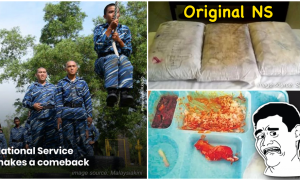Besides Genting and 4D, this little Ipoh house is the only place you can legally gamble.
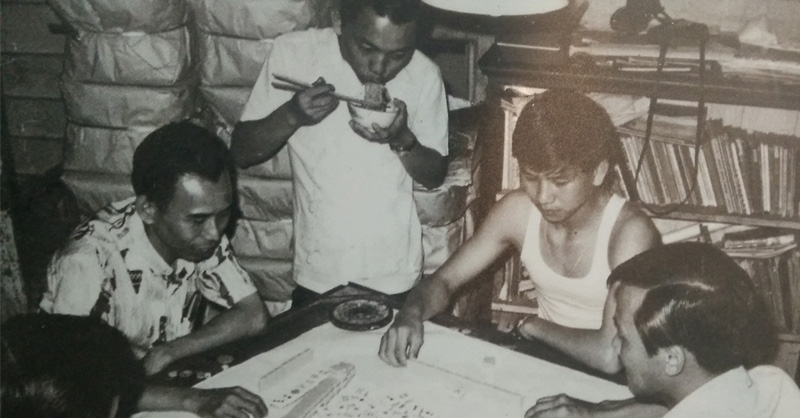
- 2.0KShares
- Facebook1.9K
- Twitter9
- LinkedIn11
- Email13
- WhatsApp75
[This article was originally published in 2018.]
Last year, on a random trip to Ipoh, one of our parents recommended we visit this little shoplot called Han Chin Pet Soo. And it’s the most interesting shoplot we’ve ever been to in Malaysia. In fact, tourists seem to agree with us too. If you check TripAdvisor, Han Chin Pet Soo comes out at #1 in Ipoh, and #6 in the whole of Malaysia!
What’s so special about this shoplot? Well, way back in the day, it was a gathering place for Chinese miners, but today, it’s a doorway to Ipoh’s colourful past, a museum that’s funded by the people of Ipoh who want to remember its culture. As we strolled its interiors, the guides told us ALOT about Ipoh that we had never heard of before.
Seeing as how Chinese New Year is upon us again, we thought it’d be a good time to take a look at this place cos…
Yes, it’s the only place in Malaysia where it’s legal to play Mahjong
Every year, hundreds of people are arrested for gambling in Malaysia. And yes, it is technically illegal to gamble in Malaysia, EXCEPT in Genting (and all those 4D outlets -_-) AND as the guides will tell you, in Han Chin Pet Soo.

The evidence! An old memo from the Perak Government in 1897 allowing gambling to members
“The Members of the Chinese Club, Ipoh, have permission to gamble in their house, pending the issue of a formal license” – memo sent by the District Magistrate of Kinta, Cecil P. Villy, to the Assistant Magistrate Ipoh, on the 1st February 1897
So way back in the late 1800s to early 1900s, Han Chin Pet Soo was the meeting place of the Hakka Miner’s Club, and as part of their offerings, they applied for permission to gamble, before the Malaysian Common Gaming Law was established in 1953. The house never heard back about an update about their permit, so it exists to this day. However, it’s *probably* never used, since Han Chin Pet Soo has now become one of Malaysia’s quirkiest historical landmarks.
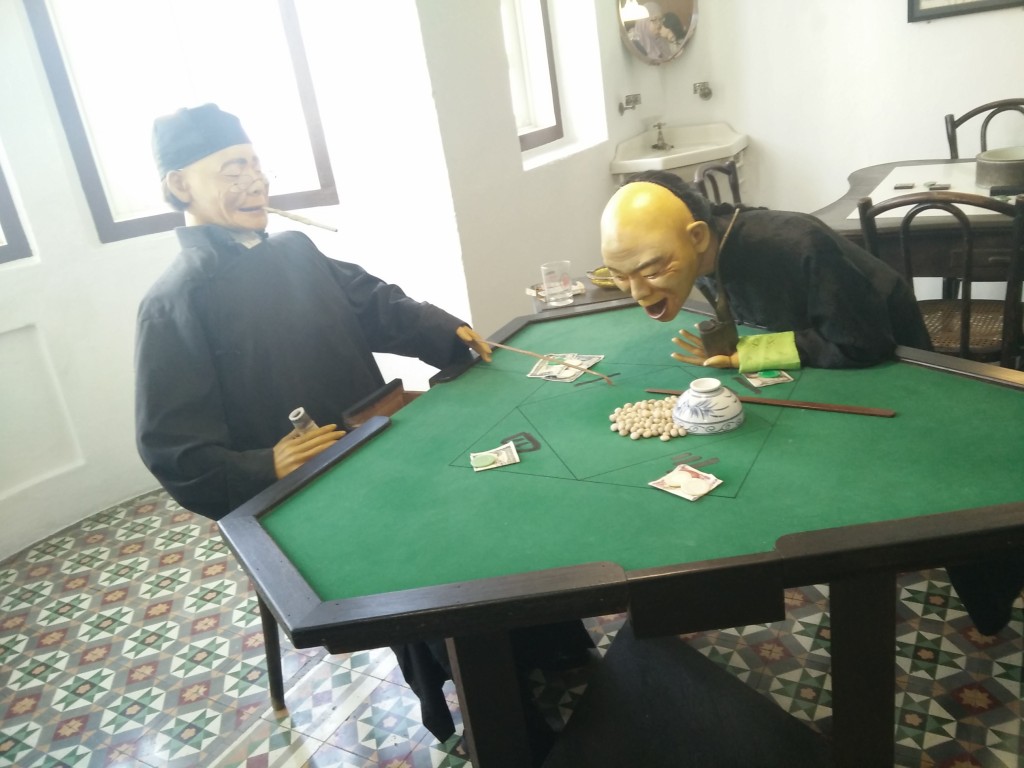
Han Chin Pet Soo is full of these life-like dolls. Looks like the most fun anyone’s ever had with soya beans
Another game played there was Fan-Tan (shown above), in which a random bunch of dried soya beans is left in the middle of the table, and covered in a bowl. Bets are then put on the numbers 1,2,3 and 4 in the four corners of the table, after which, the bowl is uncovered. The groupier then removes 4 beans at a time, until the last beans are left on the table – and the winner is the one who guessed correctly how many are left at the end.
But sadly, aunties weren’t allowed to play
Unfortunately, your grandaunties wouldn’t have been able to enjoy the mahjong tables because wives weren’t allowed inside the club, eventhough most of the mining bosses had between 4-8 wives each. The only women allowed in the club were only snuck in through the backdoor, and they were primarily Japanese prostitutes, brought in as entertainment for the men (yes, times were different then). Their price? 1 sen per night.
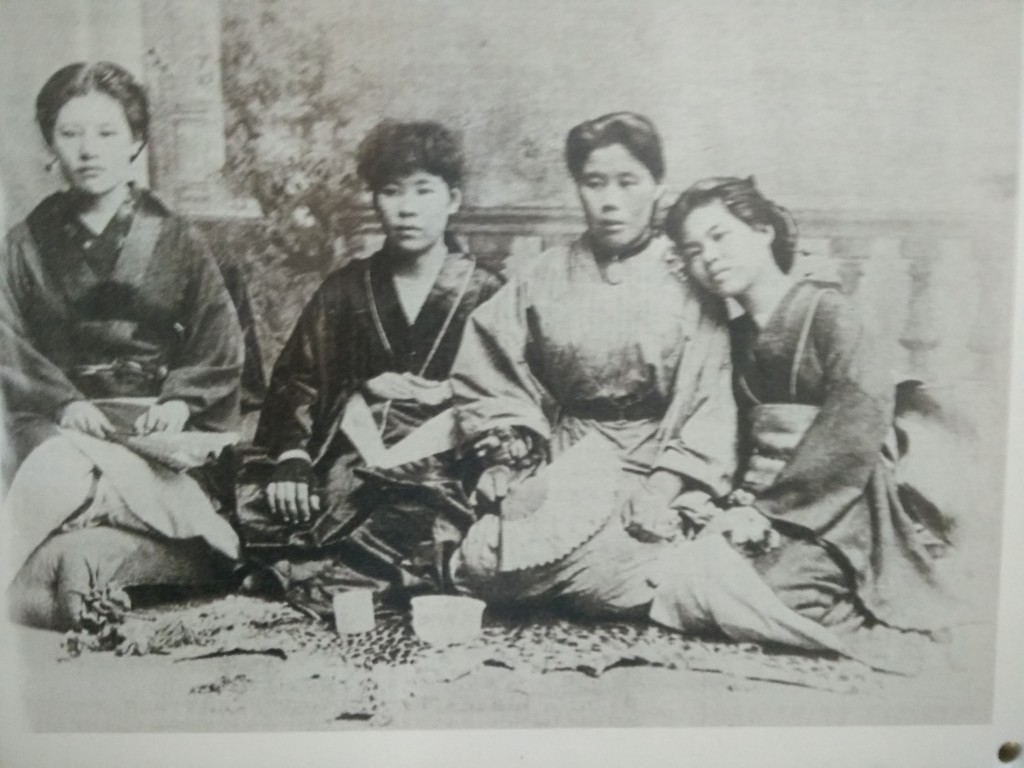
Japanese prostitutes in a photo on the wall of Han Chin Pet Soo
To put that in perspective, at the time… Tin miners earn 10sen a day, and a permit to mine tin cost 1 dollar a year. Japanese consorts were common during that time, because Japan’s economy wasn’t so power back then la.
“Japanese prostitution started during the early 1880s, tapered off in the 1920s and finally ended just before the outbreak of the Second World War in 1941. This integral part of our social history is seldom heard off due to the taboo attached to it. But for me, I feel that this interesting segment of our nation’s past needs to be told as it is binds the complex social and economic forces in Malaya, China and Japan,” – Dr Chua Hock Khoon, Malaysian historian, to NST
On top of prostitution and gambling, the house also has a history in opium, with several devices shown that were used back in the day, including some really comfy looking WOODEN pillows.
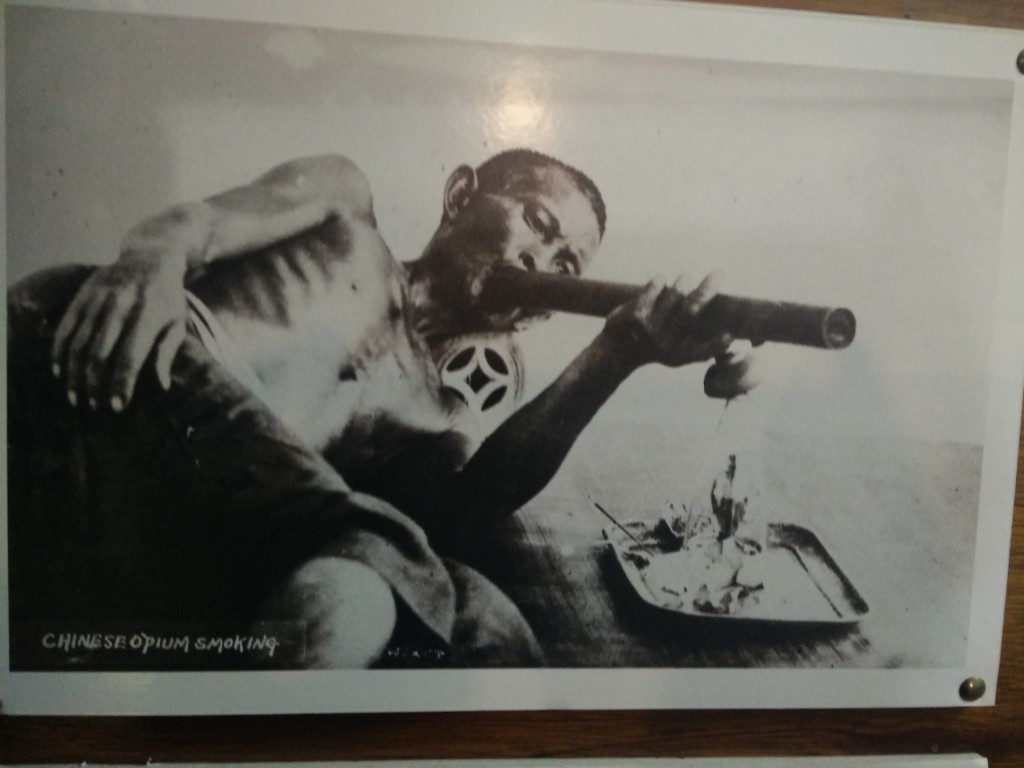
We wouldn’t buy THAT pillow on Lazada
“During that period, these vices were not illegal and there was even a tax on opium and prostitution. There is an opium den where members can get their fix of opium on the large opium beds and prostitutes, including Japanese ones, were easily available to members for private trysts in rooms on the third floor. There is also a private gambling room for members where they can gamble, drink and be entertained by the dancing and singing girls.” – A Glimpse At The Life of Hakka Tin Miners in Ipoh, Malaymail Online, Feb 26th 2015
The display at the museum names these as the 4 evils – opium, prostitutes, gambling and secret triads. There’s even a display of diplomas that show successful initiation into the “Hung Society” (heh), which includes an oath of allegiance requiring the applicant to drink a mixture of chicken blood and his own. Ew.
And amazingly, it used to house the richest men in Ipoh

During the Taiping Rebellion civil war (in China, not in Taiping which didn’t exist yet), many Hakka immigrants left to find their fortunes around the world. In 1876, a 19-year old man named Leong Fee, arrived in Penang, looking to make his fortune in Malaya. Working for 6 months first as a cook in Penang and eventually a clerk, his travels eventually led to a small bunch of Malay huts near the Kinta River, where he brought his ancestral Tua Pe Kong tablet from China and started the God of Prosperity Temple there.
Initially starting out as a clerk, he eventually built a business prospecting tin, and built Ipoh’s first line of brick houses on Leech Street in 1893. The same year, he also built a clubhouse for the Chinese Hakka miners to hang out at… sort of a ‘gentlemen’s club’, and thus Han Chin Pet Soo was founded. It had gambling rooms, lodging, and was open to Hakka miners only, allowing them a home away from home, a hot meal, and of course, a game of mah-jong.
At the time, miners from China (known as “Piglets”, or “Sinkeh”) were literally arriving by the jam-packed boatload, to relatively poor conditions still in Ipoh.
“As I looked around me at my new home, I noted it was in very poor condition, much worse than our home in China. Clearly, life was not going to be easy here. I felt disturbed and worried for the future.” – Tet Ching, a miner who arrived in Ipoh in 1926
Thankfully, Leong Fee was one of the best prospectors in Malaya, opening a mine in Tambun which in a year became the world’s largest tin mine. He also came to be regarded as the top man in Ipoh, owning rubber plantations and a host of mansions and properties in the early 1900s. He was wealthy enough not to care about membership fees, and funded the club entirely on his own wealth until his death in 1912.
“Leong Fee passed away on 8th April 1912, soon after returning from Japan and Hong Kong, leaving behind four wives, several concubines and numerous broken-hearted sing-song girls that were brought in to entertain the members of the different miners’ clubs, such as the Han Chin Pet Soo, which he had founded in 1893.” – Ipohworld
His son purposely devalued the land to sell it to members, who have been running it ever since, and it housed some of the richest men in the state, including Foo Choo Choon, who was in the early 1900s known as the “Richest Chinaman in the world“, thanks to his massive tin-mining fortune. Another affluent member was Lee Meng Hin, who’s family eventually went on to found the IOI Group which exists in Malaysia to this day. These affluent patrons allowed Han Chin Pet Soo to be possibly the first house in Ipoh with electricity in 1930.
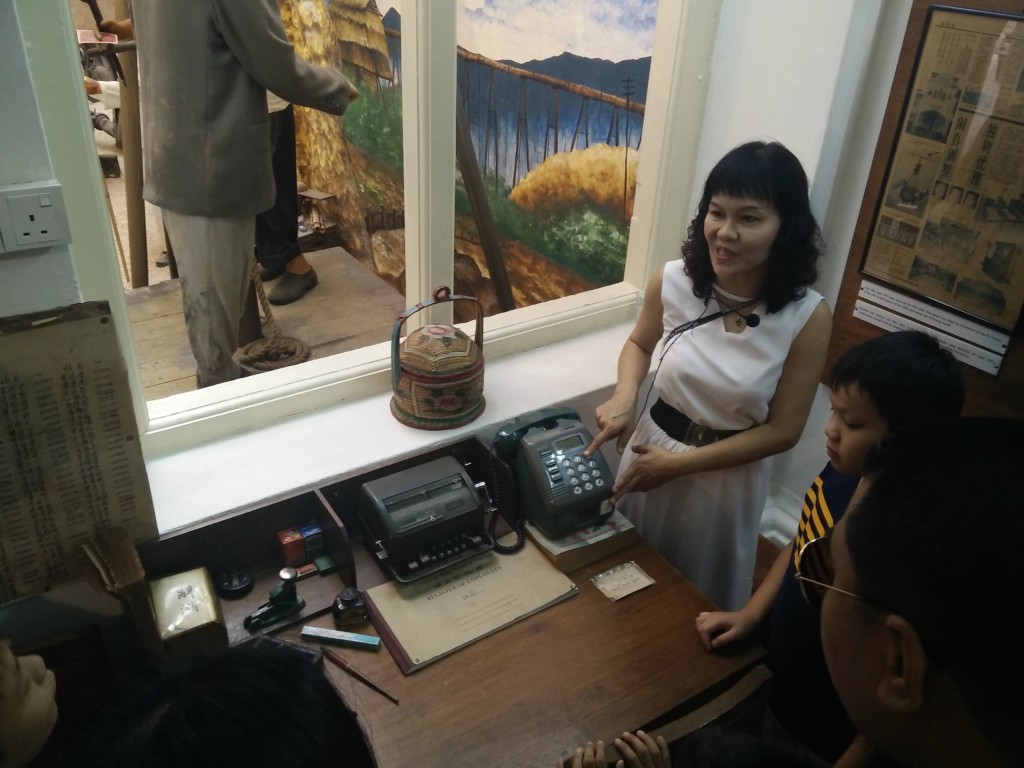
Wah got phone all! Ho Modern ahhh
Sadly, the tin boom stopped, but the house still stands
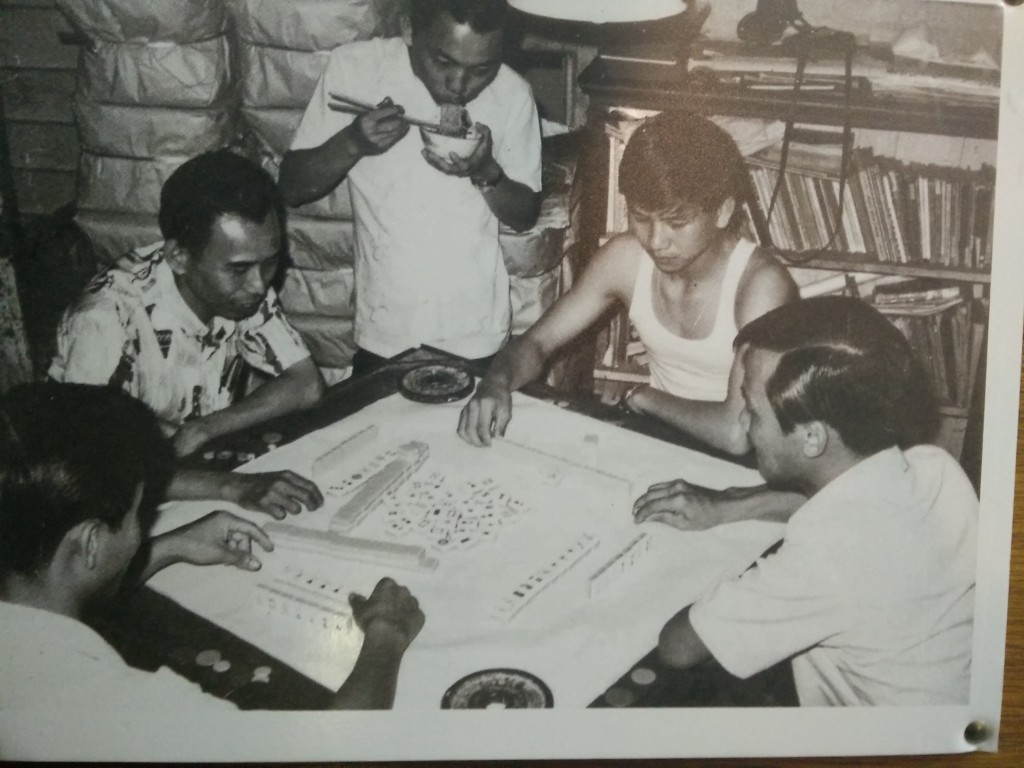
Aside from a brief closure (and fake sale) during the Japanese occupation, Han Chin Pet Soo continued to thrive together with the tin industry (1960s installed aircon woohoo!), up until the mid 80s, when the price of tin took a sharp decline due to competition from Brazil. While tin miners continued to use the club, the membership fees were insufficient to maintain it, and the club soon fell into disarray – with termites making their way into much of the structure, and pigeons making homes in its bed and bathrooms. By 2012, there were insufficient tin miners to maintain the club.
Thankfully in 2015, the club agreed to lease the house to a heritage company known as IpohWorld, who restored it to its former glory, and made it one of Malaysia’s top tourist destinations.

Srsly. You won’t believe how much history they fit inside
To be honest, there’s so much to see in this small little shoplot, that a 1500-word article can’t possibly cover – you really need to see for yourself how much charm, education and entertainment can be wrapped into a small 5000 square foot area. Don’t forget, Han Chin Pet Soo doesn’t entertain walk-ins. You HAVE to make a reservation online. But the members that take you on the tours are knowledgeable, friendly and pretty entertaining too.
Oh, and thankfully these days, women don’t have to go through the back door anymore 🙂
- 2.0KShares
- Facebook1.9K
- Twitter9
- LinkedIn11
- Email13
- WhatsApp75




